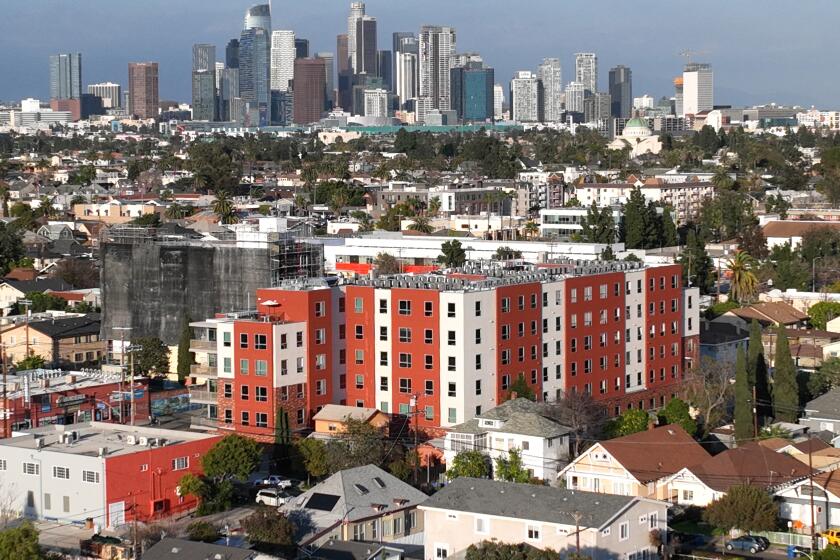Drug Abuse Program for Asians : Suicidal Addict Decides His Life Is Worth One Last Call
- Share via
Four months ago, 41-year-old Paul Manasas, a heroin addict since age 12, was ready to kill himself with an injection of rat poison. He was tired of being in and out of prison, failing every relationship he started and shooting up not to get high but to avoid feeling sick.
“I actually had the needle pricked under the first layer of skin. . . . I wanted to die. I was just on the brink,” he recalled. “I even called a friend, a former drug addict, begging him to give me one word, to say I wasn’t really a worthless human being.”
The friend, a member of Narcotics Anonymous, urged him to join a drug treatment program. Manasas, who was trying to come clean for the third time in 10 years, was sure no one would accept him.
But then he remembered he had met a former staff member of the Asian American Drug Abuse Program; he figured that might be a way in. At the last minute, he called group. “I wanted to believe I was worth at least one last phone call.”
Inferiority Complex
Manasas--who is half Filipino, half white and whose stepmother is Japanese--said other rehabilitation programs had not worked for him largely because their staff did not understand his shyness and “inferiority complex.”
But this one was different. The Asian-American program is the only drug abuse program in Los Angeles targeting Asians.
Last year, its 70-resident unit for hard-core abusers treated 14 Japanese-Americans, 13 Chinese-Americans and 4 Filipino-Americans.
Including outpatient and prevention services, where staff members carry anti-drug messages to students and ethnic communities citywide, the program reaches more than 10,000 people a year.
“I feel comfortable being around Asians and their ways are familiar to me,” Manasas said. “I don’t think I could be in another program even if it was easier to do. I wouldn’t feel the closeness.”
Other program residents, for example, did not laugh at him when he spoke the pidgin English he had learned to feel comfortable with in Hawaii; the counselors understood his shame and guilt at having destroyed his family name.
Mike Watanabe, program executive director, noted that a wide range of cultural attitudes and values often treasured by Asian families--such as pride and filial obligation--could be overlooked in a program not targeted at Asians.
“Asians communicate by inference generally,” Watanabe said. “They’re not as long-winded and they rely on the listener to understand what they mean.”
That makes Asians less likely to open up in group discussions used in traditional drug programs and more likely to shortchange themselves on treatment, said Al Mizuno, residential director. “They go through the program very, very smoothly. They don’t create any waves, they do all the right things,” he said. “We have to try to tear that down and get to the feelings, and that is awfully difficult.”
Another obstacle that addicts encounter is the belief that Asians do not need a drug program. “It’s a myth that we are successful and we don’t have social problems,” Watanabe said.
Statistics from the Los Angeles County Drug Abuse Program Office--which distributes money to nonprofit drug treatment and prevention programs nationwide--show that Asians represent only 1% to 2% of the county’s 35,000 annual admissions to publicly funded drug programs.
“They represent the smallest ethnic group as far as seeking treatment. They just do not show up,” said Don McAllister, chief of data, evaluation and research for the drug abuse office.
But Watanabe said he is sure the problem is greater than statistics show: “There’s a million Asians out there in L.A. and research shows that 40% of high schoolers are experimenting with drugs. There are thousands and thousands of Asians out there using drugs.”
Yvette, a 24-year-old Japanese-American and program resident for three months who asked her family name not be used, started smoking marijuana in the seventh grade. In high school, she stole her parents’ alcohol, brought it to school and in the bathroom mixed it with her orange juice.
“My parents were real hip. They were very liberal, very open-minded. They don’t speak Japanese,” she said. “All the Asians that I know drink and use.”
Yvette entered the program only after things got much worse and her stepmother intervened.
“I almost died twice when I was freebasing (cocaine). I’m epileptic and twice I had seizures and lost consciousness. Someone gave me mouth-to-mouth and I went straight back for the pipe. I kick myself in the butt for that,” she said.
“I started losing everything I had worked for. My stepmother said if I really wanted to get my act together I should call AADAP,” Yvette said. “I was just real tired of being tired. A freebase high only lasts a few minutes . . . and coming down off it was 10 times worse.”
Yvette said she maintained decent grades and a daily job while snorting cocaine and only “fell apart” when she began freebasing.
Prevention director Cheryl Sekiya said that because Asian youths often can take drugs and “still look OK and still get good grades,” it can be difficult to identify them as drug abusers. With that “model minority stereotype, (students) might listen in class, do their homework, it’s like they’re OK and (the teachers) don’t take a second look,” she said.
When the Asian-American program moved to its present site in a former hotel on South Crenshaw Boulevard in 1977, it shared its space with addicts shooting up in another part of the building.
Now those addicts are gone, and program residents share Spartan rooms on the top floor of a two-story building painted a drab manila-envelope beige and flanked by a Firestone tire shop and a beauty salon.
Addicts who join the program are served teriyaki, chow mein and kimchi. The kitchen goes through more than 200 pounds of rice a week.
Waiting List
Most residents go through the program in 16 to 19 months (though there is sometimes a three-month waiting list). Their treatment consists mainly of group sessions where they are “confronted with their attitudes, their character defects and why they’re rejected,” Mizuno said.
“We get them to say, ‘OK, well, I’m a jerk. Do I want to change it?’ ”
If they do, they spend several months writing resumes, seeking jobs and learning how to sell themselves at an interview.
Even with the salaries their jobs bring, most residents cannot afford the treatment, which costs $1,800 per resident per month. Most of that sum is paid by federal and state taxes and county money. Resident fees and donations make up only 7% of the program’s $1-million annual budget.
Watanabe said the average abuser in the program is a fourth-generation Japanese-American addicted to cocaine. There is more abuse, per capita, among Japanese-Americans than any other Asian groups, probably because they have been in America longer and have become more Westernized.
Residents who complete the program’s in-house treatment still might return for house meetings, to volunteer eight hours a month to work with residents and “maintain some semblance of a productive life style” for at least three months before they are “graduated” from the program.
While only three residents graduated last year, Mizuno says the others aren’t necessarily considered failures. “They may drink, they may change jobs but they are mostly off of heroin and coke, or other hard drugs,” he said.
But, he admits, up to half the residents “drop off” or are sucked back into their former life styles because they no longer have a support system.
“It may seem pointless to the community at large . . . but saving three or four people is not pointless,” Mizuno said. “The rewards are great for anybody who can be rehabilitated, and it’s well worth the effort to rehabilitate them.”
More to Read
Sign up for Essential California
The most important California stories and recommendations in your inbox every morning.
You may occasionally receive promotional content from the Los Angeles Times.










